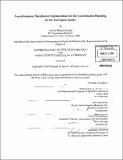| dc.contributor.advisor | Mark Abramson and Balakrishnan. | en_US |
| dc.contributor.author | Herold, Thomas Michael | en_US |
| dc.contributor.other | Massachusetts Institute of Technology. Operations Research Center. | en_US |
| dc.date.accessioned | 2011-02-23T14:27:14Z | |
| dc.date.available | 2011-02-23T14:27:14Z | |
| dc.date.copyright | 2010 | en_US |
| dc.date.issued | 2010 | en_US |
| dc.identifier.uri | http://hdl.handle.net/1721.1/61192 | |
| dc.description | Thesis (S.M.)--Massachusetts Institute of Technology, Sloan School of Management, Operations Research Center, 2010. | en_US |
| dc.description | Cataloged from PDF version of thesis. | en_US |
| dc.description | Includes bibliographical references (p. 189-194). | en_US |
| dc.description.abstract | Recent decades have seen the development of more advanced sensor and communication systems, with the future certainly holding more innovation in these areas. However, current operations involve "stovepipe" systems in which inefficiencies are inherent. In this thesis, we examine how to increase the value of Earth observations made by coordinating across multiple collection systems. We consider both air and space assets in an asynchronous and distributed environment. We consider requests with time windows and priority levels, some of which require simultaneous observations by different sensors. We consider how these improvements could impact Earth observing sensors in two use areas; climate studies and intelligence collection operations. The primary contributions of this thesis include our approach to the asynchronous and distributed nature of the problem and the development of a value function to facilitate the coordination of the observations with multiple surveillance assets. We embed a carefully constructed value function in a simple optimization problem that we prove can be solved as a Linear Programming (LP) problem. We solve the optimization problem repeatedly over time to intelligently allocate requests to single-mission planners, or "sub-planners." We then show that the value function performs as we intend through empirical and statistical analysis. To test our methodologies, we integrate the coordination planner with two types of sub-planners, an Unmanned Aerial Vehicle (UAV) sub-planner, and a satellite sub-planner. We use the coordinator to generate observation plans for two notional operational Earth Science scenarios. Specifically, we show that coordination offers improvements in the priority of the requests serviced, the quality of those observations, and the ability to take dual collections. We conclude that a coordinated planning framework provides clear benefits. | en_US |
| dc.description.statementofresponsibility | by Thomas Michael Herold. | en_US |
| dc.format.extent | 194 p. | en_US |
| dc.language.iso | eng | en_US |
| dc.publisher | Massachusetts Institute of Technology | en_US |
| dc.rights | M.I.T. theses are protected by
copyright. They may be viewed from this source for any purpose, but
reproduction or distribution in any format is prohibited without written
permission. See provided URL for inquiries about permission. | en_US |
| dc.rights.uri | http://dspace.mit.edu/handle/1721.1/7582 | en_US |
| dc.subject | Operations Research Center. | en_US |
| dc.title | Asynchronous, distributed optimization for the coordinated planning of air and space assets | en_US |
| dc.type | Thesis | en_US |
| dc.description.degree | S.M. | en_US |
| dc.contributor.department | Massachusetts Institute of Technology. Operations Research Center | |
| dc.contributor.department | Sloan School of Management | |
| dc.identifier.oclc | 701072916 | en_US |
